Abstract
The roles of monocytes and T lymphocytes in the regulation of human peripheral blood erythroid burst-forming units (BFU-E) were studied in erythropoietin-containing plasma clot cultures of subpopulations of human blood mononuclear cells. BFU-E growth was decreased significantly after depletion of monocytes alone (mean 11% of expected, range 0 to 42% of expected) or depletion of both monocytes and T cells (mean 6.5% of expected, range 0.5 to 12% of expected) from mononuclear cells. T cell depletion did not impair BFU-E growth in vitro. Using 10(5) monocyte- and T lymphocyte-depleted mononuclear cells as target cells (less than 1% monocytes, less than 5% T cells), BFU-E growth was restored to 40% of expected by addition of 10(4) monocytes, and to 96% of expected by 10(5) monocytes alone. Addition of as many as 2 X 10(5) T cells but no monocytes resulted in stimulation to only 34% of expected BFU-E growth. Addition of 2 X 10(4) T cells, which alone did not affect BFU-E growth, could augment significantly the stimulatory effect of 5-20 X 10(3) monocytes on BFU-E growth. Thus, monocytes alone appear to be capable of stimulating BFU-E growth in vitro in the presence of erythropoietin. T cells also may make small quantities of BFU-E stimulators. However, it seems more likely that the most important role of T lymphocytes in BFU-E regulation in vitro is a result of interactions with monocytes and augmentation of monocyte production of stimulators of BFU-E growth.
Full text
PDF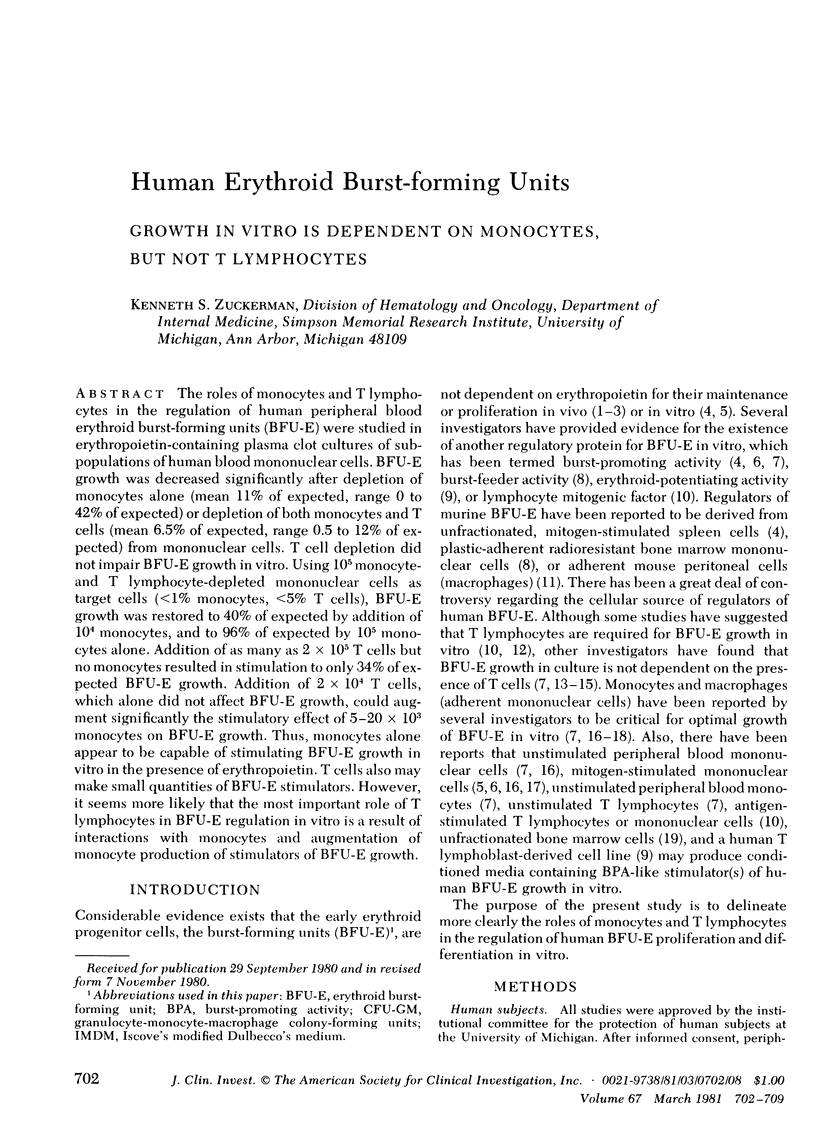
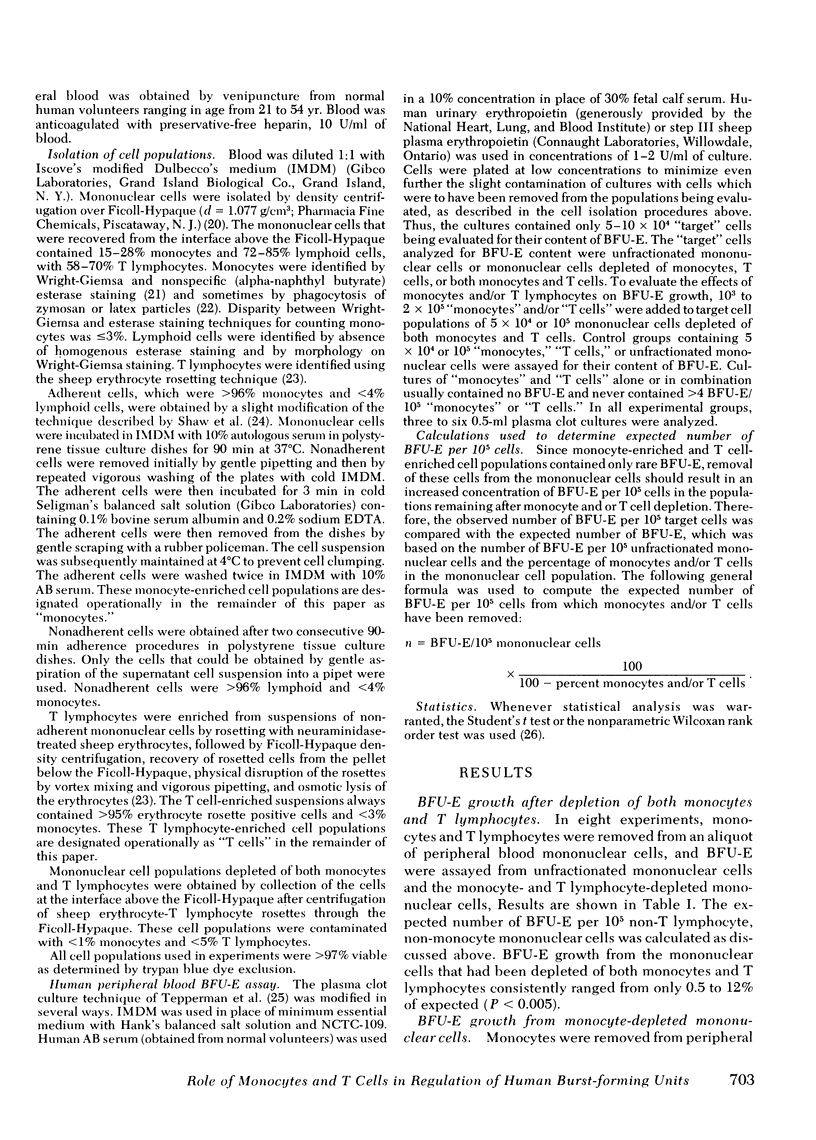
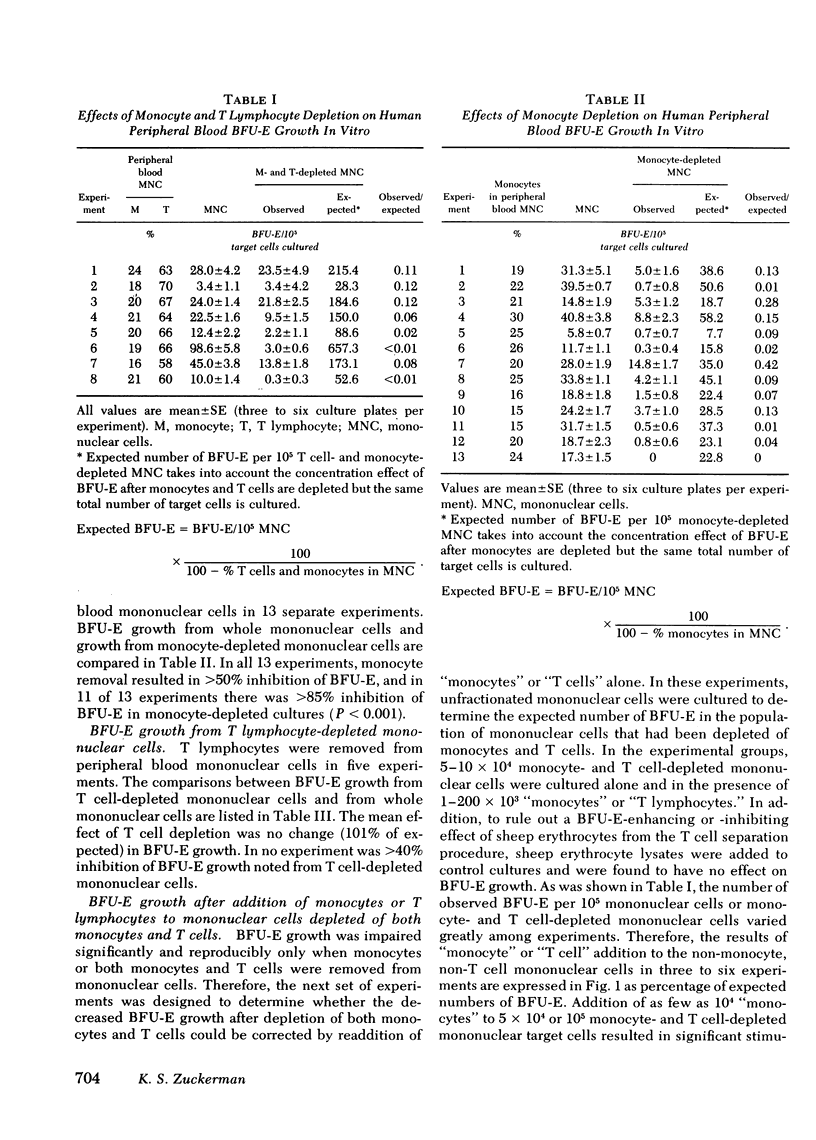
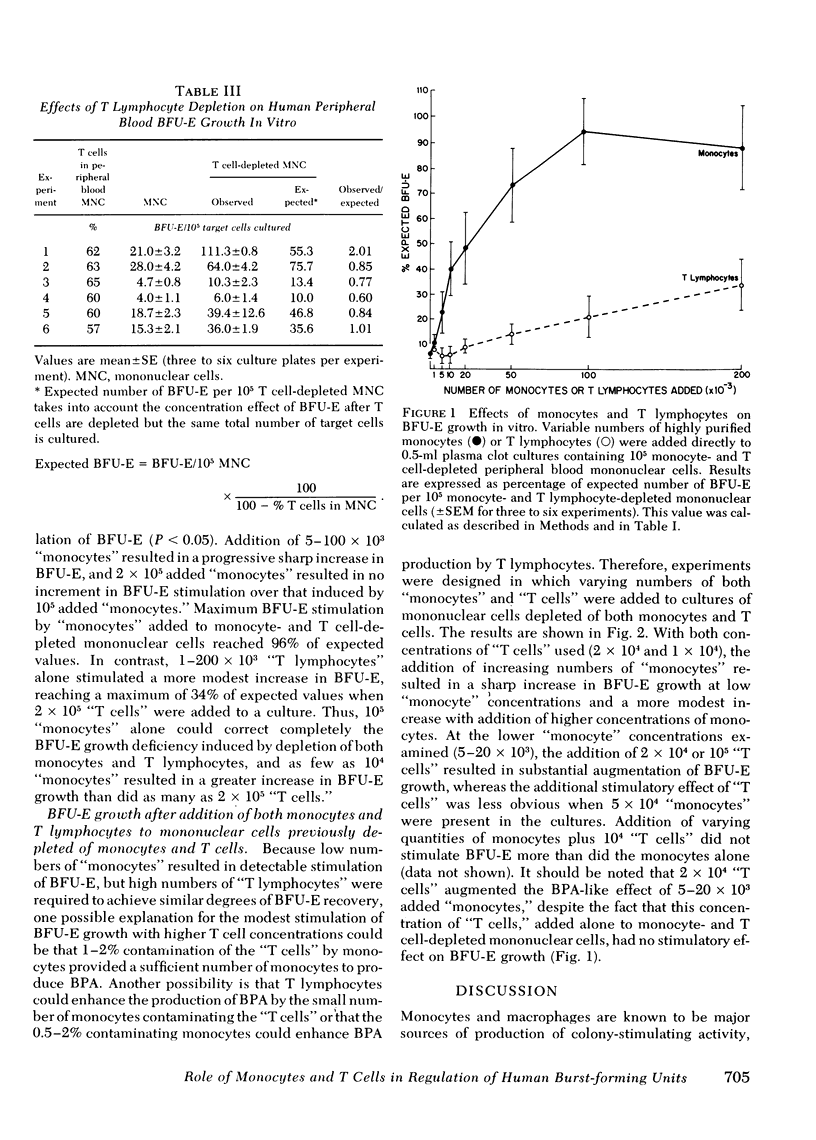
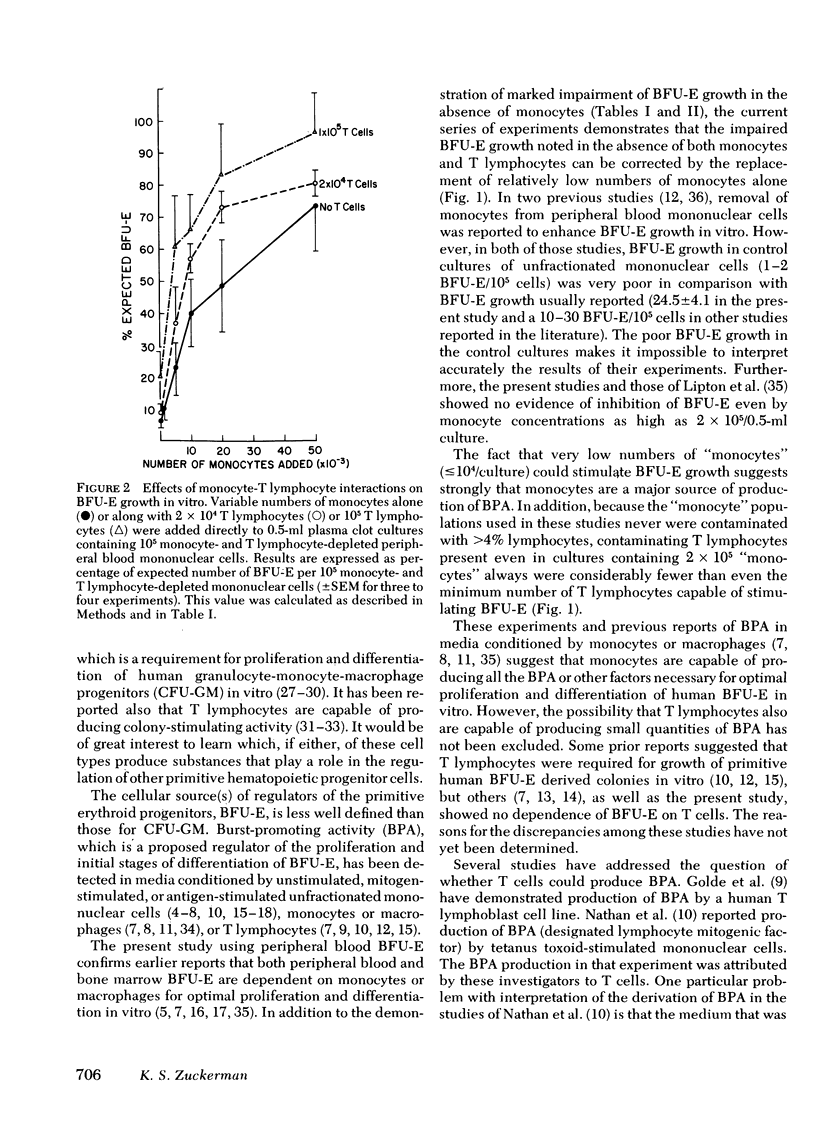
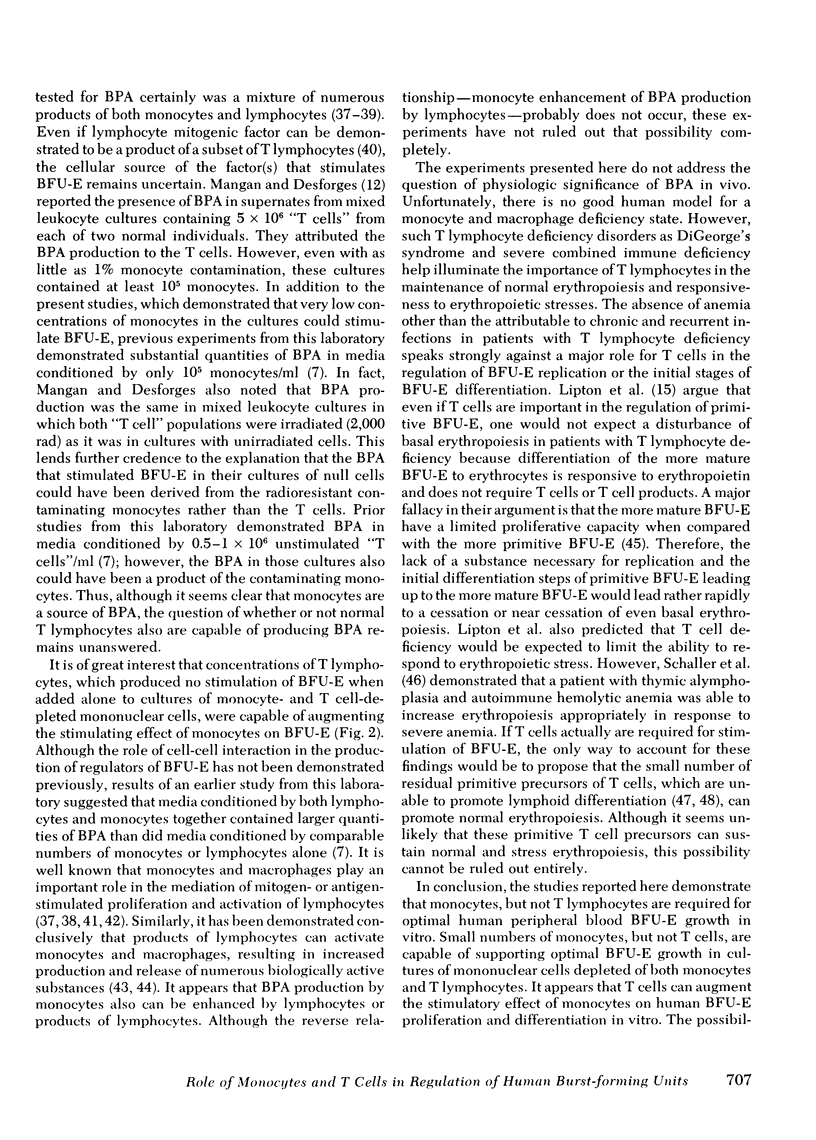
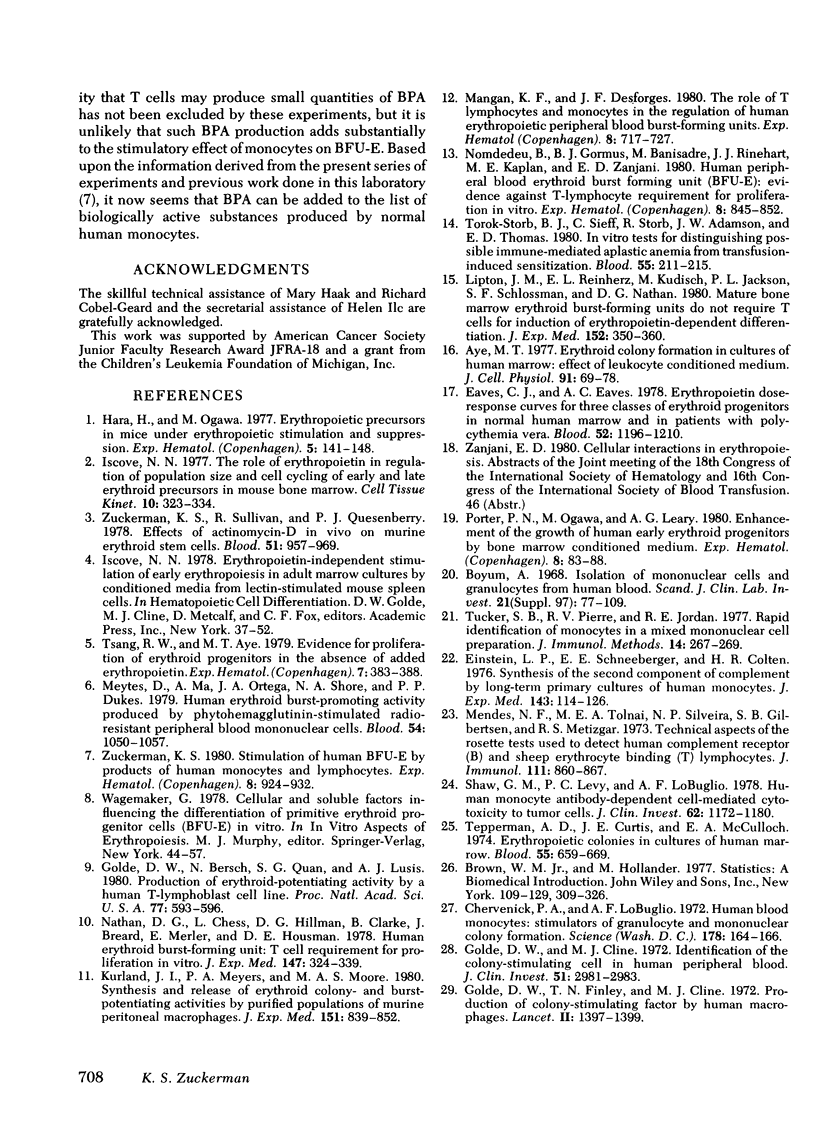
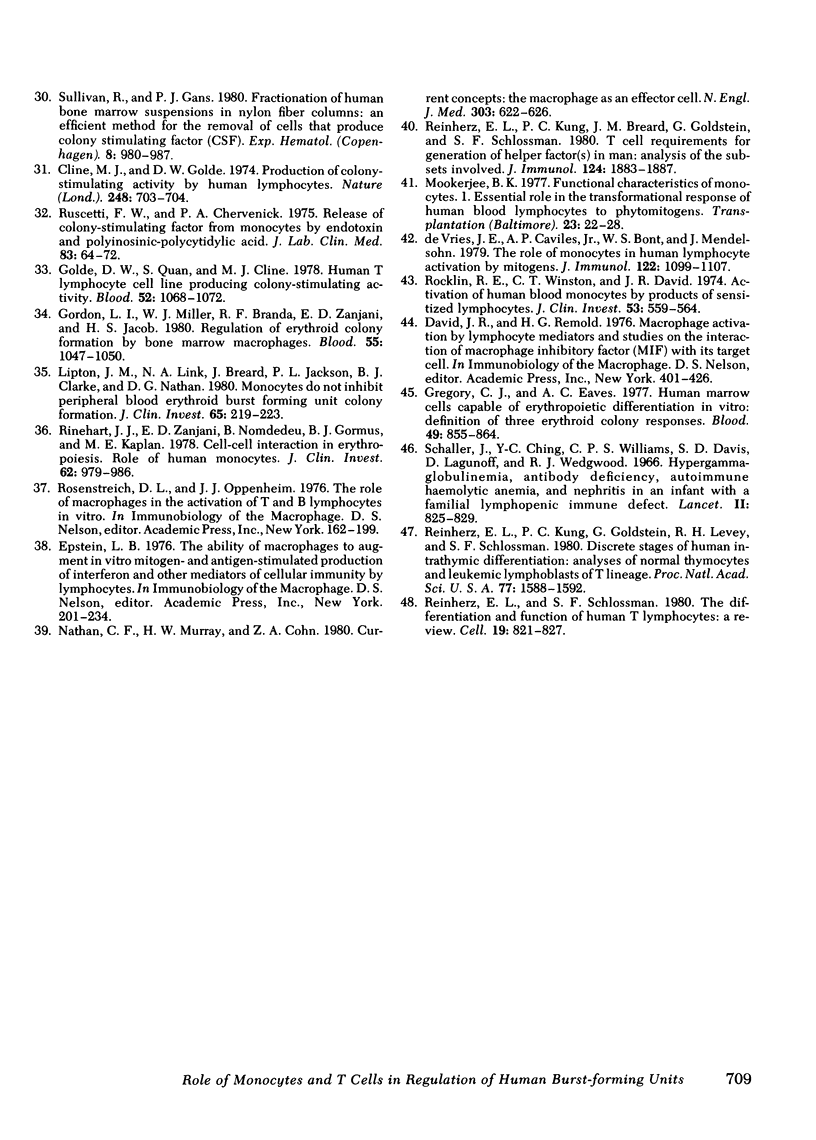
Selected References
These references are in PubMed. This may not be the complete list of references from this article.
- Aye M. T. Erythroid colony formation in cultures of human marrow: effect of leukocyte conditioned medium. J Cell Physiol. 1977 Apr;91(1):69–77. doi: 10.1002/jcp.1040910108. [DOI] [PubMed] [Google Scholar]
- Böyum A. Isolation of mononuclear cells and granulocytes from human blood. Isolation of monuclear cells by one centrifugation, and of granulocytes by combining centrifugation and sedimentation at 1 g. Scand J Clin Lab Invest Suppl. 1968;97:77–89. [PubMed] [Google Scholar]
- Chervenick P. A., LoBuglio A. F. Human blood monocytes: stimulators of granulocyte and mononuclear colony formation in vitro. Science. 1972 Oct 13;178(4057):164–166. doi: 10.1126/science.178.4057.164. [DOI] [PubMed] [Google Scholar]
- Cline M. J., Golde D. W. Production of colony-stimulating activity by human lymphocytes. Nature. 1974 Apr 19;248(5450):703–704. doi: 10.1038/248703a0. [DOI] [PubMed] [Google Scholar]
- Eaves C. J., Eaves A. C. Erythropoietin (Ep) dose-response curves for three classes of erythroid progenitors in normal human marrow and in patients with polycythemia vera. Blood. 1978 Dec;52(6):1196–1210. [PubMed] [Google Scholar]
- Einstein L. P., Schneeberger E. E., Colten H. R. Synthesis of the second component of complement by long-term primary cultures of human monocytes. J Exp Med. 1976 Jan 1;143(1):114–126. doi: 10.1084/jem.143.1.114. [DOI] [PMC free article] [PubMed] [Google Scholar]
- Golde D. W., Bersch N., Quan S. G., Lusis A. J. Production of erythroid-potentiating activity by a human T-lymphoblast cell line. Proc Natl Acad Sci U S A. 1980 Jan;77(1):593–596. doi: 10.1073/pnas.77.1.593. [DOI] [PMC free article] [PubMed] [Google Scholar]
- Golde D. W., Cline M. J. Identification of the colony-stimulating cell in human peripheral blood. J Clin Invest. 1972 Nov;51(11):2981–2983. doi: 10.1172/JCI107124. [DOI] [PMC free article] [PubMed] [Google Scholar]
- Golde D. W., Finley T. N., Cline M. J. Production of colony-stimulating factor by human macrophages. Lancet. 1972 Dec 30;2(7792):1397–1399. doi: 10.1016/s0140-6736(72)92966-2. [DOI] [PubMed] [Google Scholar]
- Golde D. W., Quan S. G., Cline M. J. Human T lymphocyte cell line producing colony-stimulating activity. Blood. 1978 Nov;52(5):1068–1072. [PubMed] [Google Scholar]
- Gordon L. I., Miller W. J., Branda R. F., Zanjani E. D., Jacob H. S. Regulation of erythroid colony formation by bone marrow macrophages. Blood. 1980 Jun;55(6):1047–1050. [PubMed] [Google Scholar]
- Gregory C. J., Eaves A. C. Human marrow cells capable of erythropoietic differentiation in vitro: definition of three erythroid colony responses. Blood. 1977 Jun;49(6):855–864. [PubMed] [Google Scholar]
- Hara H., Ogawa M. Erythropoietic precursors in mice under erythropoietic stimulation and suppression. Exp Hematol. 1977 Mar;5(2):141–148. [PubMed] [Google Scholar]
- Iscove N. N. The role of erythropoietin in regulation of population size and cell cycling of early and late erythroid precursors in mouse bone marrow. Cell Tissue Kinet. 1977 Jul;10(4):323–334. doi: 10.1111/j.1365-2184.1977.tb00300.x. [DOI] [PubMed] [Google Scholar]
- Kurland J. I., Meyers P. A., Moore M. A. Synthesis and release of erythroid colony- and burst-potentiating activities by purified populations of murine peritoneal macrophages. J Exp Med. 1980 Apr 1;151(4):839–852. doi: 10.1084/jem.151.4.839. [DOI] [PMC free article] [PubMed] [Google Scholar]
- Lipton J. M., Link N. A., Breard J., Jackson P. L., Clarke B. J., Nathan D. G. Monocytes do not inhibit peripheral blood erythroid burst forming unit colony formation. J Clin Invest. 1980 Jan;65(1):219–223. doi: 10.1172/JCI109653. [DOI] [PMC free article] [PubMed] [Google Scholar]
- Lipton J. M., Reinherz E. L., Kudisch M., Jackson P. L., Schlossman S. F., Nathan D. G. Mature bone marrow erythroid burst-forming units do not require T cells for induction of erythropoietin-dependent differentiation. J Exp Med. 1980 Aug 1;152(2):350–360. doi: 10.1084/jem.152.2.350. [DOI] [PMC free article] [PubMed] [Google Scholar]
- Mangan K. F., Desforges J. F. The role of T lymphocytes and monocytes in the regulation of human erythropoietic peripheral blood burst forming units. Exp Hematol. 1980 Jul;8(6):717–727. [PubMed] [Google Scholar]
- Mendes N. F., Tolnai M. E., Silveira N. P., Gilbertsen R. B., Metzgar R. S. Technical aspects of the rosette tests used to detect human complement receptor (B) and sheep erythrocyte-binding (T) lymphocytes. J Immunol. 1973 Sep;111(3):860–867. [PubMed] [Google Scholar]
- Meytes D., Ma Ortega J. A., Shore N. A., Dukes P. P. Human erythroid burst-promoting activity produced by phytohemagglutinin-stimulated, radioresistant peripheral blood mononuclear cells. Blood. 1979 Nov;54(5):1050–1057. [PubMed] [Google Scholar]
- Mookerjee B. K. Functional characteristics of monocytes. 1. Essential role in the transformational response of human blood lymphocytes to phytomitogens. Transplantation. 1977 Jan;23(1):22–28. [PubMed] [Google Scholar]
- Nathan C. F., Murray H. W., Cohn Z. A. The macrophage as an effector cell. N Engl J Med. 1980 Sep 11;303(11):622–626. doi: 10.1056/NEJM198009113031106. [DOI] [PubMed] [Google Scholar]
- Nathan D. G., Chess L., Hillman D. G., Clarke B., Breard J., Merler E., Housman D. E. Human erythroid burst-forming unit: T-cell requirement for proliferation in vitro. J Exp Med. 1978 Feb 1;147(2):324–339. doi: 10.1084/jem.147.2.324. [DOI] [PMC free article] [PubMed] [Google Scholar]
- Nomdedeu B., Gormus B. J., Banisadre M., Rinehart J. J., Kaplan M. E., Zanjani E. D. Human peripheral blood erythroid burst forming unit (BFU(E)): evidence against T-lymphocyte requirement for proliferation in vitro. Exp Hematol. 1980 Aug;8(7):845–852. [PubMed] [Google Scholar]
- Porter P. N., Ogawa M., Leary A. G. Enhancement of the growth of human early erythroid progenitors by bone marrow conditioned media. Exp Hematol. 1980 Jan;8(1):83–88. [PubMed] [Google Scholar]
- Reinherz E. L., Kung P. C., Breard J. M., Goldstein G., Schlossman S. F. T cell requirements for generation of helper factor(s) in man: analysis of the subsets involved. J Immunol. 1980 Apr;124(4):1883–1887. [PubMed] [Google Scholar]
- Reinherz E. L., Kung P. C., Goldstein G., Levey R. H., Schlossman S. F. Discrete stages of human intrathymic differentiation: analysis of normal thymocytes and leukemic lymphoblasts of T-cell lineage. Proc Natl Acad Sci U S A. 1980 Mar;77(3):1588–1592. doi: 10.1073/pnas.77.3.1588. [DOI] [PMC free article] [PubMed] [Google Scholar]
- Reinherz E. L., Schlossman S. F. The differentiation and function of human T lymphocytes. Cell. 1980 Apr;19(4):821–827. doi: 10.1016/0092-8674(80)90072-0. [DOI] [PubMed] [Google Scholar]
- Rinehart J. J., Zanjani E. D., Nomdedeu B., Gormus B. J., Kaplan M. E. Cell-cell interaction in erythropoiesis. Role of human monocytes. J Clin Invest. 1978 Nov;62(5):979–986. doi: 10.1172/JCI109227. [DOI] [PMC free article] [PubMed] [Google Scholar]
- Rocklin R. E., Winston C. T., David J. R. Activation of human blood monocytes by products of sensitized lymphocytes. J Clin Invest. 1974 Feb;53(2):559–564. doi: 10.1172/JCI107590. [DOI] [PMC free article] [PubMed] [Google Scholar]
- Ruscetti F. W., Chervenick P. A. Release of colony-stimulating factor from monocytes by endotoxin and polyinosinic-polycytidylic acid. J Lab Clin Med. 1974 Jan;83(1):64–72. [PubMed] [Google Scholar]
- Schaller J., Davis S. D., Ching Y. C., Lagunoff D., Williams C. P., Wedgwood R. J. Hypergammaglobulinaemia, antibody deficiency, autoimmune haemolytic anaemia, and nephritis in an infant with a familial lymphopenic immune defect. Lancet. 1966 Oct 15;2(7468):825–829. doi: 10.1016/s0140-6736(66)92255-0. [DOI] [PubMed] [Google Scholar]
- Shaw G. M., Levy P. C., LoBuglio A. F. Human monocyte antibody-dependent cell-mediated cytotoxicity to tumor cells. J Clin Invest. 1978 Dec;62(6):1172–1180. doi: 10.1172/JCI109236. [DOI] [PMC free article] [PubMed] [Google Scholar]
- Sullivan R., Gans P. J. Fractionation of human bone marrow cell suspensions in nylon fiber columns: an efficient method for the removal of cells that produce colony stimulating factor (CSF). Exp Hematol. 1980 Sep;8(8):980–987. [PubMed] [Google Scholar]
- Tepperman A. D., Curtis J. E., McCulloch E. A. Erythropietic colonies in cultures of human marrow. Blood. 1974 Nov;44(5):659–669. [PubMed] [Google Scholar]
- Torok-Storb B. J., Sieff C., Storb R., Adamson J., Thomas E. D. In vitro tests for distinguishing possible immune-mediated aplastic anemia from transfusion-induced sensitization. Blood. 1980 Feb;55(2):211–215. [PubMed] [Google Scholar]
- Tsang R. W., Aye M. T. Evidence for proliferation of erythroid progenitor cells in the absence of added erythropoietin. Exp Hematol. 1979 Aug;7(7):383–388. [PubMed] [Google Scholar]
- Tucker S. B., Pierre R. V., Jordon R. E. Rapid identification of monocytes in a mixed mononuclear cell preparation. J Immunol Methods. 1977;14(3-4):267–269. doi: 10.1016/0022-1759(77)90137-5. [DOI] [PubMed] [Google Scholar]
- Zuckerman K. S. Stimulation of human BFU(E) by products of human monocytes and lymphocytes. Exp Hematol. 1980 Aug;8(7):924–932. [PubMed] [Google Scholar]
- Zuckerman K. S., Sullivan R., Quesenberry P. J. Effects of actinomycin D in vivo on murine erythroid stem cells. Blood. 1978 May;51(5):957–969. [PubMed] [Google Scholar]
- de Vries J. E., Caviles A. P., Jr, Bont W. S., Mendelsohn J. The role of monocytes in human lymphocyte activation by mitogens. J Immunol. 1979 Mar;122(3):1099–1107. [PubMed] [Google Scholar]


